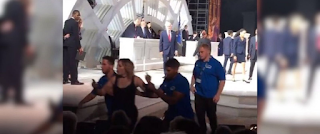This post passes along a fascinating explanation (excerpted) into the origins of our right against self-incrimination. But first, the back story to this post. The picture shows the arm of Christopher Slavin. He and an accomplice tricked two Mexican men to enter his car on Long Island, promising day labor at a warehouse. In the basement, Slavin attacked one man with a post-hole digger and almost killed him. He’s serving 25 years-life.
At trial, the issue was whether this assault was aggravated by racial animus. The state wanted to enter evidence of intent via photographs of Slavin’s neo-Nazi tattoos. The trial and appeals court upheld the introduction of this evidence. Credit defense lawyers with arguing, however, that the tattoos amounted to confessions of a hate crime—a really good argument on these facts.
If you read to the bottom, you’ll see how the state argued that use of the tattoos does not violate the right against self-incrimination.
….
Pretrial criminal procedures in the Middle Ages had no privilege against self-incrimination. At arraignment, the accused was required to expressly admit that he was the person charged.
After pleading not guilty, he was required to answer a second question about how would he be tried. The rights to battle, ordeal, or oath had to be relinquished before the case could be tried by a jury. The expected answer was “By God and my country.”
If there was a refusal to give this specific answer (assuming there was no issue about physical or mental ability to speak), there was a heavy penalty for recalcitrance. In cases of a felony, the method was peine forte de dure, which involved the piling up of weights upon the accused until he consented to a trial by jury. Other tortures and deprivations were also employed, even unto death when, if life left him, judgment found him. In cases of treason or misdemeanor, the refusal to answer was construed as a plea of guilt and the matter proceeded directly to determination of punishment.
One major factor in upgrading the tenet against self-betrayal into a rule of law was widespread opposition to the canonical oath de veritate dicenda, also known as the ex officio oath. Regularly used in the ecclesiastical courts but also in the prerogative courts, the ex officio oath required a defendant to swear under oath that he would answer all questions put to him truthfully without any prior knowledge of the subject of inquiry whatsoever.
This practice was detested because it led to all kinds of fishing expeditions for evidence of immorality, religious heterodoxy, or political dissent. In the 1550’s, during the reign of Queen Elizabeth I, both Catholics, who wanted a return to the Roman rites, and Puritans, who wanted to shed the dregs of popery, were frequently persecuted. By seeking a writ of prohibition in the common law courts, they tried to stop the use of the ex officio oath with limited success….
Compulsory process by law arrived in 1562. After enactment of the Statute of Elizabeth, 5 Elizabeth I, c. 9, § 12, a statutory penalty and right to sue was created for witnesses who refused to testify in a civil case, provided there had been proper service of process and tender of expenses…. Eventually compulsory process evolved from a duty to attend into the duty to disclose all knowledge.
Beginning in the late 1700's and into the nineteenth century, the criminal process in England became adversarial. The increased use of defense counsel reduced the expectation that the accused would offer a defense himself. Private associations of prosecutors arose to defray the victim's costs.
….
The relevant text of the Fifth Amendment states “no person shall be compelled in any criminal case to be a witness against himself.” Therefore, the word “witness” limits the category of compelled incriminating statements to those that are testimonial in character.
Counsel for Slavin has focused on the “communicative” aspect of the tattoos and urges that they fit under the Schmerber “shadow of testimonial compulsion.” This argument ignores the contemporaneousness component of compulsion. The New York State Court of Appeals has defined “testimonial or communicative evidence” to be that which reveals a person's subjective knowledge or thought processes.
However, prior voluntary communicative acts are distinguishable from contemporaneous communicative acts which retain the testimonial aspect required under Fifth Amendment analysis. People v. Holmes, 304 A.D.2d 1043 (3d Dept. 2003) (tattoo with nickname “Polo” was communicative but its display to jury was non-testimonial); People v. Spruill (alteration of tattoo from “Pike” to panther was proper evidence of guilty conscience); People v. Mars, 266 A.D.2d 316 (2d Dept. 1999) (love letters from defendant to non-spouse, which were found by defendant's estranged husband, were admissible to prove motive). Prior voluntary communicative acts without any contemporaneous testimonial aspect, lack the element of compulsion needed to bring them within the constitutional privilege.





































